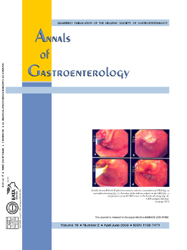Endoscopic treatment of gastroesophageal varices
Abstract
Variceal bleeding continues to be a leading cause of deathin cirrhotic patients. Both vasoactive drugs and endoscopic
therapy play a significant role in the acute variceal bleeding
setting as well as in primary and secondary prevention
of variceal bleeding. All patients with cirrhosis should be
screened with endoscopy for varices at diagnosis.
In primary prevention, prophylaxis should be offered in
patients with medium and large varices. Although endoscopic
variceal ligation seems to be more effective than nonselective
beta-blockers in preventing first variceal bleeding
it does not improve survival rate. Considering the small
number of patients enrolled in the randomized trials, the
inability of endoscopic ligation to prevent bleeding from
portal gastropathy, the cost and the safety issues related to
ligation we recommend beta-blockers as the first line treatment.
Endoscopic variceal ligation should be offered to
patients with at least medium varices and contraindications
or intolerance to beta-blockers. In acute variceal bleeding
the treatment of choice is the combination of endotherapy
with vasoactive drugs, particularly when administration of
drugs started early before endoscopy. Endoscopic sclerotherapy
has been shown to reduce bleeding and increase
survival, but recently endoscopic ligation has been considered
to be superior to sclerotherapy in this setting. The risk
of recurrent bleeding and death following an episode of
variceal bleeding is very high. In patients who have not received
primary prophylaxis the combination of EVL and
beta blockers should be used in this setting. In patients
who are on beta-blockers for primary prevention EVL should
be added. Patients who fail endoscopic and pharmacological
treatment should undergo TIPS, surgical shunts or liver
transplantation.




